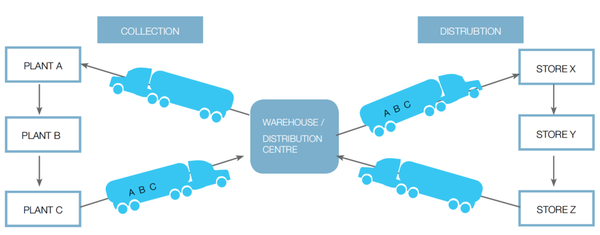 Effective inventory management is crucial to the logistics of every retail business, whether you sell in a single store or have a thriving global, multi-channel business.
Effective inventory management is crucial to the logistics of every retail business, whether you sell in a single store or have a thriving global, multi-channel business.
Inventory management helps you stay on top of stock, so you can avoid disappointing customers with out-of-stocks and tying up capital with too much stock.
But if you store inventory in multiple locations (i.e. some stock in store, some products in your spare bedroom, and others in a warehouse), tracking and managing all that product can be challenging. Centralizing your inventory is one way that retailers can keep track of what’s on hand, what’s headed out the door, and what’s coming in.
To help you understand if centralizing your inventory is the right move for your business, let’s take a look at the concept, how it can benefit your business, and the steps you can take to start centralizing your own operations.
What Is Centralized Inventory?
Centralized inventory is when you keep stock in a single location. Businesses essentially merge all their products into one place to make inventory management simpler.
In retail, it’s when you keep your stock at a single hub and restock your store and fulfill any online or phone orders from that central hub. Your centralized inventory hub could be on-location (in your store, for example) or at an off-site warehouse.
Benefits of Centralized Inventory
Centralizing your inventory could reap your business and operations team a number of benefits. But the benefits that impact your business most really come down to your unique processes, operations, and needs.
“Retailers that are strictly ecommerce or only have a single store have the most to gain from centralized inventory,” says Jacquie Young-Sterling, director of customer experience at retail audit firm Compliantia. “Since they’re only packing and shipping, they have far fewer logistics to be concerned about when compared to a multi-unit retailer and can run their entire business from their warehouse.”
Operational Efficiency
One core benefit that those who move to a centralized inventory seek is operational efficiency. Charles Dimov, vice president of marketing at OrderDynamics, agrees that this is one key upside to this approach. “Centralized inventory in a distribution center can be great for operational efficiency,” he says. “Distribution centers are very efficient pick-pack-and-ship centers.”
But it also has the potential to increase efficiency in a brick-and-mortar environment. For one, with a single location for your stock, you and your employees are all looking at the same thing. There are no discrepancies in the inventory data between different people’s views. When this is the case, everyone in your business can make decisions based on the same information.
A centralized inventory can streamline your inventory channel, saving you time,” says Young-Sterling.
Because everyone’s looking at the same data, communications are more efficient as well. You don’t need to spend as much time explaining the information or getting someone up to speed because they’ve already had the chance to do so independently.
“Having a centralized inventory for your business means you have a dedicated team tasked with receiving, fulfilling replenishment, and shipping orders carefully and cost-effectively,” Young-Sterling says. “This means your internal team doesn’t have to put customer service, marketing, or on-site sales on hold to deal with products coming in or going out.”
Multichannel Management
Today’s consumers are shopping in a variety of ways — both online and in-store. In fact, only 7% of shoppers buy online-only, compared to 73% who use more than one sales channel throughout the purchase process. This is likely why nearly three-quarters of retailers are prioritizing efforts to sell their products across multiple channels.
When you make the move to a multichannel retail business, there are a lot more factors, workflows, and people to consider as you try to keep everything synced. It can help simplify processes when you manage all orders from a single location, reducing the risk of fulfilling an order twice or selling something in-store that’s already been purchased online.
“Inventory centralization works when a retailer chooses not to run a ship-from-store model,” Dimov suggests. “Ship-from-store leverages in-store inventories to fulfill in-store and online orders for an omnichannel retailing play.”
Cost Savings
 Centralizing your inventory can also be a way to reduce expenses in your retail business. Because your data is more accurate and operations are more efficient, you’re able to reduce the amount of time and resources required to complete specific tasks in your business, like fulfilling orders or pulling inventory reports.
Centralizing your inventory can also be a way to reduce expenses in your retail business. Because your data is more accurate and operations are more efficient, you’re able to reduce the amount of time and resources required to complete specific tasks in your business, like fulfilling orders or pulling inventory reports.
Plus, accurate data means better-informed business decisions, which can reduce costly mistakes. Retailers lose $1.75 trillion annually from out-of-stocks, overstocks, and returns. The opportunity to boost revenues is also hard to ignore — research shows you can also increase profits 50% with improved inventory management. Meanwhile, shrinkage was responsible for taking $100 billion out of the pockets of retailers globally in 2017.
Drawbacks to Centralized Inventory
While there are several benefits to centralized inventory, it really boils down to the type of business you run. Centralized inventory isn’t right for every retailer. At OrderDynamics, for example, they look at the individual business to determine whether centralized inventory is the way to go.
Dimov points out that there are several other tools available to retailers that can help them increase efficiency, manage multiple sales channels, and save money while doing it.
“With solid order management software (OMS), retailers can use ship-from-store to use the field inventory to fulfill online orders, for example,” Dimov says. “Rather than centralizing, use the OMS to give you a complete view of the inventory on hand. Good systems will give retailers a global inventory picture regardless of location.”
Centralized inventory can also hinder a retailer’s ability to be nimble and meet changing demand. With stock in a single location, it can be difficult to fulfill orders when there’s been a spike in demand in a specific geographic region or weather makes fulfillment impossible from your single warehouse.
That being said, brick-and-mortar retailers who have stores in a single region may not face those types of challenges in their normal operations.
“The most obvious time to look at centralized inventory is if a retailer is looking to start heavily investing in their ecommerce presence while not expanding their brick-and-mortar presence nationwide,” recommends Young-Sterling. “Logistics is key here. If you have brick-and-mortar locations worldwide, centralized inventory is probably not a wise decision for your company. The last thing you want is your in-store experience to suffer because you moved your logistics hub too far away from some of your stores.”
Again, it all comes down to your unique business needs to determine whether centralized inventory will work best for you.
How to Centralize Your Inventory
If you’ve decided that you want to centralize your inventory, there are a few key considerations when making the transition.
Find the Right Inventory Management Tool
First, you’ll want to set yourself up with an inventory management software that can centralize your inventory.
We’ve listed five inventory management tools that you can look into to get started, which include:
- Stitch Labs: This is a great all-in-one tool that specializes in inventory management, complete with a virtual warehouse to prevent out-of-stock and backorders, cross-channel selling and a partner network of tools. One of their customers created their own customer loyalty program with Sitch’s API. Stitch Labs is recommended for retailers that are growing rapidly.
- TradeGecko: TradeGecko syncs your inventory with your online selling channels and offers customer data and real-time tracking. It’s also great for wholesale retailers, as it has both B2C- and B2B-specific features.
- Ordoro: A more affordable (free) inventory management system, Ordoro also manages inventory across multiple channels and keeps the data in a single place. It also has specific shipping and dropshipping features. Ordoro is an ideal tool for smaller-sized retail businesses who ship a lot of product.
- Shopify POS: Our own point-of-sale tools accept in-person payments, so you can make transactions on the go. It helps you track inventory and share data between the POS and your online store. You can also apply discounts for customers, email receipts, and process refunds.
- Xero: Xero works with many inventory management tools, so it’s a great way to keep multiple sources of data together. Plus, your inventory management tools will communicate with one another, providing you a more holistic view of your business. Xero automatically exports orders, simplifies your accounting processes and provides easy-to-understand reporting.
You can also ask for referrals in your network and check out options on sites like Merchant Maverick, Capterra, and Product Hunt.
“Your inventory management system needs to be intelligent enough to track in-store stock, warehouse stock, and items in ecommerce carts,” says Young-Sterling.
Follow the Hub-and-Spoke Model
When it comes to determining where and how exactly to keep stock so it’s centralized, Dimov describes the “hub and spoke model” for inventory management and order fulfillment.
“Main or larger stores are the hubs. From these, online, mobile, voice, and other store orders can be picked, packed, and shipped to customers. Spoke stores are the smaller locations with limited inventory levels, which rely on hubs and the distribution centers for additional fulfillment and delivering on the endless-aisle concept.”
He recommends determining inventory for the hub, spoke, and distribution centers by looking at which products are most popular based on both geography and sales channel. Put the fastest-moving stock in your spoke stores, a more comprehensive selection of merchandise in your hub stores, and use the distribution center to stock your stores and fulfill online orders.

Logistics companies like FedEx, UPS, and Yellow Freight all use this model to move more products faster.
Get Organized
Not every retailer will have a setup as described above, though. That’s why Young-Sterling recommends a methodical approach to centralizing inventory.
“Get super organized,” she says. “Centralized inventory is meant to create efficiencies for your company. [That won’t happen] if staff can’t find SKUs within the warehouse, or the product is shown to be in stock when it isn’t.”
The way you organize SKUs for your business may differ from the next retailer; the best approach depends on how your warehouse is set up and even who your warehouse manager is.
“Different people like to organize differently, as long as you can find what you need fast, that’s all that matters,” says Young-Sterling.
This may be based on SKU number or product category. Whatever it is, it’s important to come up with a system and document it so that all internal team members can adhere to your organization system. A floor plan is also a great idea.
In terms of warehouse organization, Young-Sterling does have one tip that’s applicable to all businesses.
“Keep your top-selling items grouped together,” she says. “That way your staff isn’t running to all corners of the warehouse to pick the same few items all day long.” It’s also important to keep the warehouse clutter-free, making it easier for staff to navigate.
Getting organized also means regular inventory audits.
“Inventory audits are always a necessary evil,” says Young-Sterling. “Regardless of how good a company’s inventory management system is, there will always be inaccuracies due to theft, damage, shipping mistakes, etc.”
FURTHER READING: Learn more about how to do a full inventory audit.
So, just how often should you conduct inventory audits? Again, the answer depends on your unique business needs. Some retailers only do this annually, whereas others might even conduct audits on a weekly basis. If you’re having issues managing your inventory, you’ll likely want to increase the frequency until those issues have been identified and addressed.
An experienced warehouse manager can also assist in the transition to centralized inventory, Young-Sterling says. She recommends making it a priority to find a qualified individual to step in.
Moving Forward With Centralizing Your Inventory
How do you manage inventory for your retail business? Do you think centralized inventory would work for you?

